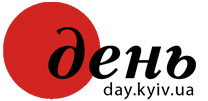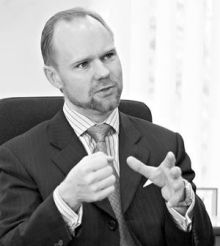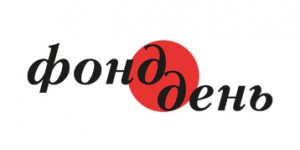Ukraine’s political leadership has spared little fanfare in presenting the year 2011 as one marking the return of this country’s attractive foreign inland investment environment. Among other things, they have enacted the Tax Code, set about simplifying authorization procedures, enacting anticorruption laws. Any effect on investors? How are they faring in Ukraine? How much are they prepared to invest in Ukraine’s economy, considering the latest legislative changes? More on this in the following interview with EBRD Director in Ukraine Andre KUUSVEK.
In mid-April, the EBRD Board of Governors adopted a new 2011-14 strategy in Ukraine. What’s the difference between this and the previous one?
“The previous one was adopted in 2007. Four years later, the world was gripped by a deep-reaching financial crisis that couldn’t have left Ukraine unaffected. Back in 2007, we couldn’t have known about Ukraine during and after the crisis, of course. Therefore, all consequences were taken into account in the new strategy. It also details the key EBRD guidelines; three EBRD key priorities in Ukraine for the next couple of years, namely investments in the energy sphere, agribusiness, and energy-saving technologies. These priorities can be adjusted depending on the situation in Ukraine and elsewhere in the world. For us the main thing is supporting a competitive business environment in Ukraine, so that business can be done unimpeded and in accordance with market laws in your country, no matter where this business comes from.”
How would you estimate the status of Ukraine after two years of crisis?
“Markedly less domestic capital and international investments compared to the situation before the crisis; noticeably lower funding. April 2011 macroeconomic indices are better than those of April 2010. Of course, these achievements largely depended on the efforts of all those in power, yet there was also the factor of the world economic and foreign market situation getting better.”
INVESTMENT CLIMATE WORSENING
Are there any signs of Ukrainian investment climate getting better?
“No. There are signs pointing to the contrary. Corruption remains. Our clients say that local businesses are being ruthlessly pressured by local regulatory authorities, sustaining devastating inspections by sanitary, tax, environmental, and other officials. It is obvious that your government will be hard put to cope with this budget situation without IMF support. It is also obvious that your government is trying to add to the central budget’s income items, proceeding from IMF recommendations. It is also true, however, that a number of acts on the part of your government, while meant to improve the budget situation, end up having a negative effect on business. Much has been said about company VAT refunds (none of them have been able to get their money back). Business people also complain about having to pay the income tax in advance.”
When do you think Ukraine will get its economy back to pre-crisis level?
“There is no getting GDP growth index back to its level before the crisis this year, considering the 40 percent devaluation of the hryvnia and the heavy industrial output drop (minus 15 percent in 2009). I believe that Ukraine will reach its pre-crisis indices in two or three years, sometime in 2014 — yet this, too, will largely depend on the presence of [foreign inland] investments in this country.”
The EBRD helps countries with transit economies adjust to a market economy status. Do you believe that Ukraine has made this adjustment over the past 20 years? Would you refer to Ukraine’s economy as a market one?
“Progress has been made; it is apparent. Ukraine, however, remains for us a country with a transit economy. Take your GDP: in 2009, it was a mere 70 percent of that back in 1991. Basic market economy rules are effective (there is the competition between the great many foreign and Ukrainian domestic companies), but there aren’t enough specific quality results that would make us happy.”
President Thomas Mirow, during his visit to Ukraine, declared in Kyiv that the EBRD was prepared to invest about one billion euros in this country every year. Where will this money go in 2011?
“In 2011, our financial capacities and appetite for risk equal a billion euros. Whether this money will be provided in full measure will depend on the presence of quality projects and investors. I might as well remind you that the EBRD can finance between 35 and 50 percent of a given project. Will there be investors in the private sector?”
You mean such investors will be in short supply?
“As a matter of fact, foreign inland investors are in short supply in Ukraine. Over the past four months, only two big-time investors have emerged, both from the West, who turned to us for financial support in Ukraine. We agreed to help them. Later, one of them consulted with us and we agreed that he had to cancel the project. Why? Because of Ukraine’s investment climate. Also, because he couldn’t come to terms with the Ukrainian partner. The other investor is still there, but their project is being implemented at a snail’s pace. In Davos, the EBRD leadership met with the owners and managers of the world’s top 70 companies. Only two expressed an interest in doing business in Ukraine. The reason I mention this statistic is for you to realize that two-three investors emerging in six months, in a major European country, is abnormal. Proof enough that you must work on your investment climate.”
Is the EBRD satisfied with the manner in which Ukraine has been using its loans? What’s the percentage of the EBRD credit lines open for Ukraine?
“Most EBRD investments are channeled into the private sector (80-85 percent implemented to date); almost 100 percent implemented in the banking sector. In the state/public sector the percentage is dramatically lower because here carrying out each project takes considerably longer. All told, between 70 and 75 percent of the euro investment portfolio has been implemented.”
The new EBRD strategy reads that precise investment sums will depend on effective reforms. In other words, no progress, no money? Would you specify such no-money spheres?
“Progress must be shown in every sphere. We would like to see wholesale progress in the energy sphere, adjusting the municipal electricity bills to the cost value of power supply and investment. It is also important for these reforms to affect such large government-run companies as Ukrenerho, Ukrzaliznytsia, and Naftohaz Ukrainy.”
THE EBRD IS PREPARED TO INVEST 300 MILLION DOLLARS IN UKRAINE’S AGRIBUSINESS
There are considerable EBRD investments in agribusiness projects. Is your Bank likely to change its policy considering that Ukraine hasn’t abolished the grain quotas, and that some MPs keep insisting on further grain export restrictions, so as to keep agribusiness under government control?
“The agrarian sector is one of those that are showing the most stable progress in Ukraine. Indeed, there are VAT refunds, grain export quotas, and related paperwork problems. Your prime minister met with Thomas Mirow and promised that the grain export market wouldn’t be monopolized. Your head of state recently vetoed the bill on quota auctions. We regard these as positive signals.
“Last year, the EBRD invested some 200 million dollars in the agro-industrial complex. We are prepared to invest another 300 million in 2011; there are 10-12 potential projects under consideration. This, however, doesn’t mean that all of them will be implemented, even if the Ukrainian investment climate improves. EBRD is considering financial risks on the part of concrete company applicants.
“Of course, there are problems also with the existing projects. For example, we loaned 50 million dollars to Nibulon to build grain elevators and purchase ships for grain exports. At present, this company can’t export grain because they haven’t received the quotas, so they are suing the government while using the ships as grain storage facilities.”
In other words, this company can’t repay your loan?
“No problems here so far, considering that Nibulon is doing other business. However, EBRD can no longer extend loans for this project. I mean there are unexpected risks that may narrow the circle of companies aspiring to loans. All told, we have no problem customers in the agrarian sector.”
The EBRD mainly loans money to agrarian companies. Has the bank considered the possibility of buying grain trader stocks?
“That’s an interesting option. Your market has potential, yet the risks are enormous. It is hard to correctly determine the worth of a given company. So far we don’t understand the prospects of the Ukrainian grain market.
“In general, the EBRD will increase the share of equity in our investment portfolio. Today it is 13 percent and we plan to bring it up to 20-25 percent.”
Should Nibulon fail to repay the loan, would the EBRD become their stockholder?
“It’s too early to make forecasts. Theoretically, if and when this company fails to return the loan, this loan can be restructured as stocks (as was the case with Kreditprombank). At present we don’t have a single problem customer in the grain sector.”
How would you describe the potential of the Ukrainian agro-industrial complex? What do you think is the biggest obstacle on the road of active development here?
“Several years from now the world population will number nine billion. All these people have to be fed. I think that Ukraine is one of top three food suppliers. Russia also has good production capacities, but Ukraine has far better export prospects.
“Corruption is the biggest problem slowing down progress in your country (including in the AIC). It has taken root in all walks of life because of various apparatchiks who pursue their own interests.”
PRIVATIZATION OF UKRTELECOM: NO TRUE COMPETITION
Talking about a greater equity share in the EBRD investment portfolio. Previously your bank said it was prepared to buy up to 30 percent of the successful bidder’s Ukrtelecom stocks. Have you established a dialog with the new owner? How do you feel about the sale of this giant telecommunications company?
“There is no dialog with the new owner. In fact, we don’t know him. No one has contacted us. Frankly speaking, it’s a shame that there were all those bidder restrictions in the course of privatization. It was the second auction after selling the Kryvorizhstal [Kryvyi Rih Steel Works] that made it possible for your government to enlist a number of bidders and considerably increase the price while securing a higher level of future investments in this company. As it was, due to the restrictions, there was only one bidder. What kind of auction was it? It wasn’t an auction.”
Will the EBRD take part in the privatization of facilities in the energy sector? Do you believe the privatization process will be transparent?
“We are interested in this sector and we are prepared to cooperate with the successful bidders provided the whole process is transparent and provided it answers the EBRD criteria. Whether I believe it will be transparent, let me say this: Ukraine is so important for the international community in general, and for the EBRD stockholders in particular, that we will never lose hope.”
Energy and Coal Industry Minister Yurii Boiko recently declared that the Pomary-Urengoi-Uzhgorod section of the Ukrainian gas transportation system will start being upgraded in mid-June. Will the EBRD be involved and how? How much is the bank prepared to invest?
“At present the consultants hired using EU grants are working on the modernization feasibility study. They estimate the project at 300-350 million dollars. The EBRD is prepared to finance it in collaboration with the European Investment Bank, on a fifty-fifty basis. I’m not sure, however, that an agreement will be signed this year.”
ONE BILLION DOLLARS OVER FIVE YEARS TO UPGRADE UKRAINIAN PIPELINES
How much is the EBRD prepared to invest in the modernization of Ukrainian pipelines? Back in 2009, the EBRD, the EIB, and the IFC signed an agreement envisaging 1.5-2 billion dollars worth of loans to Ukraine for this purpose, subject to the condition of reforms in this sector. Then the process slowed down. What is the current situation?
“Back in 2009 it was about a loan to buy gas from Gazprom in exchange for reforms. Now this is no longer on the agenda. Now investment in the upgrading of gas pipelines is a different matter, the more so that your government has started reforms in this sphere, increasing the price of gas for various categories of consumers by 50 percent. There is progress. The EBRD will take part in the GTS modernization project and the Pomary-Urengoi-Uzhgorod section could be the beginning. Then more, considering that the whole project is medium-term. The fact remains, however, that the cost of comprehensive modernization has increased from 1.5-2 to 3-4, maybe even 5 billion dollars. This is big money and the EBRD may invest a billion dollars into the upgrading of the Ukrainian GTS over five years.”
What kind of reforms should Ukraine carry out in the energy sector to receive this money?
“Restructuring Naftohaz Ukrainy in the first place. There must emerge separate gas extraction, transit, sales and purchase companies with clear-cut, transparent administrative and financial management. They must be profitable, in the long run if not at once.”
Will the EBRD get involved if there is a pipeline modernization consortium including [Russia’s] Gazprom?
“That’s a possibility. Everything will depend on the structure: Who will have the controlling interest; whether the EU will be among the participants, and so on. Vladimir Putin’s recent visit to Kyiv appears to have opened up no horizons for Russia.”
Suppose Naftohaz Ukrainy can use the IPO option. Would this be an alternative to the consortium and provide the modernization money?
“That’s a possibility, considering that IPO must be preceded by the creation of a solvent, profitable company. This would fit into the pattern of necessary reforms in the energy sector. Also, funds thus enlisted could be used to upgrade the oil and gas pipelines.”
How do you feel about Ukraine’s banking sector? How much do you think the EBRD will be prepared to invest there before the end of 2011?
“This sector appears far more stable compared to 2009-10, with fewer risks. However, there are practically no loans to the real sector, except for several banks (Ukreximbank, Privat, and Russian banks’ affiliates), with the rest holding fast to their funds. In fact, this isn’t only those banks’ fault but also the absence of good projects. The EBRD plans to channel some 300 million dollars into your banking sector. Trade financing has made up the bulk of this over these two years, but now we’re looking for a way to add to the banks’ small and medium business loan portfolios — for example, in the energy-saving sector.”








